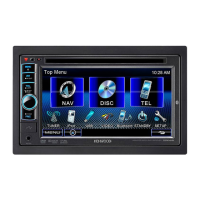Why does my Kenwood Car Video System display 'Pairing Mode Error'?
- RRyan SmithSep 8, 2025
If your Kenwood Car Video System displays “Pairing Mode Error”, register the device again.

Why does my Kenwood Car Video System display 'Pairing Mode Error'?
If your Kenwood Car Video System displays “Pairing Mode Error”, register the device again.
Why does my Kenwood Car Video System display 'Pick Up Error'?
If your Kenwood Car Video System displays “Pick Up Error”, the unit has failed to receive a call.
Why does my Kenwood Car Video System display 'Hung Up Error'?
If your Kenwood Car Video System displays “Hung Up Error”, the call has not ended yet. Park your car and use the connected mobile phone to end the call.
Why does my Kenwood Car Video System display 'Dial Error'?
If your Kenwood Car Video System displays “Dial Error”, dialing has failed. Try the operation again.
Why does my Kenwood Car Video System fail to initialize and display 'Initialize Error'?
If your Kenwood Car Video System displays “Initialize Error”, the unit has failed to initialize the Bluetooth module. Try the operation again.
How to fix Kenwood Car Video System when no sound comes out of the speakers?
If no sound is coming from the speakers of your Kenwood Car Video System, ensure the volume is at an audible level and check all cords and connections to make sure they are secure.
Why does my Kenwood Car Video System display 'NO Data'?
The message “NO Data” on your Kenwood Car Video System means that no phone book data is contained in the connected Bluetooth phone.
Why does my Kenwood Car Video System display 'NO Voice Device'?
The message “NO Voice Device” on your Kenwood Car Video System means that the connected mobile phone does not have a voice recognition system.
Why is the sound distorted on my Kenwood Car Video System when using an iPod/iPhone?
If the sound is distorted when using an iPod/iPhone with your Kenwood Car Video System, deactivate the equalizer either on the unit or the iPod/iPhone.
Why does my Kenwood Car Video System say 'No BT Dongle'?
The message “No BT Dongle” on your Kenwood Car Video System means the Bluetooth adapter (KS-UBT1) is removed.
| Brand | Kenwood |
|---|---|
| Model | DDX418 |
| Category | Car Video System |
| Language | English |
Resets the unit to factory settings, affecting operations.
Guides through initial setup, language, and AV input configuration.
Activates the security indicator to protect the receiver against theft.
Explains how to turn the unit on/off, adjust volume, and mute.
Details on putting the unit into standby and controlling the display.
Navigating between source control, Top Menu, and Setup screens.
Guides users on choosing the desired audio/video source.
Instructions for inserting, ejecting, and playing discs.
How to show playback controls on screen.
Controls for media playback like play, pause, skip, and search.
Navigates through disc folders and tracks.
Setting repeat or random playback modes.
Steps to connect, play, and safely disconnect USB storage devices.
Guides on connecting iPod/iPhone and required cables.
Adjusts iPod playback modes and artwork display.
Configures AV input settings for iPod/iPhone.
Viewing station information and text.
Saving and automatically storing favorite radio stations.
Searching programs by PTY code and managing Traffic Information.
Connects and operates external AV devices via the AV-IN terminal.
Displays and controls the navigation system guidance.
Customizes audio output using preset modes and manual equalization.
Sets crossover points for speakers and subwoofers.
Adjusts illumination colors and sets custom backgrounds.
Adjusts brightness, contrast, color, tint, and sharpness for video.
Enables and shows the rear view camera image.
Configures fader, balance, equalizer, loudness, and preout settings.
Adjusts dimmer, clock, scroll, and screen appearance.
Configures AV input and rear camera interrupt.
Manages navigation, language, beep, remote sensor, and setup memory.
Saves and restores custom configurations.
Secures settings and calibrates the touch screen.
Important information and preparation for Bluetooth connectivity.
Guides on pairing new devices and managing connections.
Connects/disconnects registered phones and audio players.
Removes paired Bluetooth devices.
Handles incoming/outgoing calls, SMS reception, and mic volume.
Accesses phone contacts, dialled, received, and missed calls.
Saves favourite numbers and copies phone book data.
Removes stored phone numbers and call lists.
Introduces the remote, its battery, and mode switch.
Basic controls like source switching, volume, and navigation.
Locates tracks/files and uses playback controls like play/pause and stop.
Adjusts subtitle, zoom, picture angle, and audio language.
Selects folders and files from media discs.
Switches radio bands, selects stations, and uses seek modes.
Searches and plays music/videos from iPod and USB devices.
Covers cleaning the unit, handling discs, and moisture condensation.
Details supported file formats (DivX, MPEG, JPEG, MP3, etc.) and their specs.
Provides solutions for common error messages displayed on the unit.
Addresses issues with sound, picture, tuner, discs, and media playback.
Troubleshoots radio reception and preset issues.
Troubleshoots disc playback errors.
Troubleshoots media file playback.
Troubleshoots external video input.
Troubleshoots iPod/iPhone connectivity and operation.
Troubleshoots USB playback and data transfer.
Troubleshoots Bluetooth phone and audio.
Technical details for the display and USB interface.
Technical details for the DVD player and Bluetooth module.
Technical details for FM/AM tuners and audio output.
Technical details for video I/O, power, dimensions, and weight.
Technical details for the USB Bluetooth adapter.
Lists and describes the included accessories.
Step-by-step instructions for installing the main unit.
Detailed diagrams for connecting wires to terminals.
Steps for physically mounting the unit and its trim piece.
Procedures for detaching the trim piece.
Steps to detach the unit from the dash.
Instructions for installing the Bluetooth microphone.
